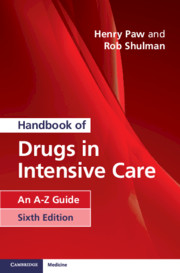Chapter K - Chapter
from Drugs: An A–Z Guide
Published online by Cambridge University Press: 18 July 2019
Summary
Ketamine is a non-competitive antagonist of N-methyl-D-aspartate (NMDA) receptors and also binds to mu and kappa opioid receptors. It is licensed as an anaesthetic agent for diagnostic and surgical procedures and is best suited to shorter procedures. It has a role in the ICU as a co-analgesic, with opioid-sparing properties. It has good analgesic properties in subanaesthetic doses. Use of midazolam or another benzodiazepine as an adjunct to ketamine reduces the incidence of emergence reactions.
Ketamine has also been used for treatment of patients with severe asthma, as it has bronchodilating properties, probably deriving from two different mechanisms – firstly, via a central effect inducing catecholamine release, thereby stimulating beta-2 (β2)-adrenergic receptors, and secondly, by inhibition of vagal pathways to produce an anticholinergic effect acting directly on bronchial smooth muscle. Ketamine is metabolized in the liver to an active metabolite – norketamine. This has a potency of around one-third that of ketamine.
- Type
- Chapter
- Information
- Handbook of Drugs in Intensive CareAn A-Z Guide, pp. 159 - 161Publisher: Cambridge University PressPrint publication year: 2019



